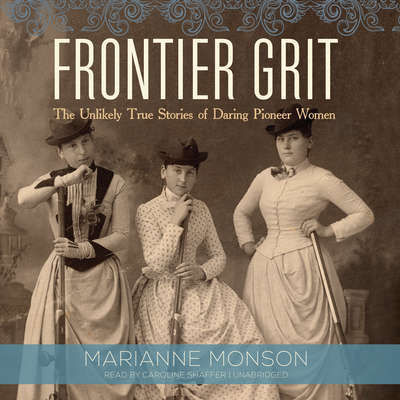 Frontier Grit – 3.5 stars
Frontier Grit – 3.5 stars
In this book we meet twelve women who traversed the American frontier in search of their dreams, though what these dreams were and the paths they took to them vary extraordinarily.
As a child I devoured Laura Ingalls Wilder’s Little House books. Though I’ve have quite a lot of bubbles burst about her depiction of her childhood (check out Caroline Fraser’s Prairie Fires to learn more), my interest in those so-called pioneers who tried to ‘tame’ the Wild West still persists, and this book was the perfect fodder of this appetite.
Monson tells the condensed stories of twelve pioneer women. In the snapshots of their lives we get to see places like the disputed ranches of old California, the gold miner camps of Alaska, and even a Hawaiian settlement in Mormon Utah. Some of the women became famous nationwide as activists, writers, and senators while others were well-known only in their communities. I liked that Monson profiled women from a diverse array of backgrounds, including many I’d never heard of before.
~
 The Paper Daughters of Chinatown – 2.5 stars
The Paper Daughters of Chinatown – 2.5 stars
When Dolly comes to teach at the Occidental Mission Home for Girls, she doesn’t know that she’s about to become a towering figure in early 20th century San Francisco as a rescuer of girls who’ve been trafficked from China.
One of the women who especially captured my imagination in Frontier Grit was Donaldina Cameron, who worked to free Chinese girls and women from slavery in San Francisco. Fiercely devoted to her mission and with a strange knack for squirreling out even the least obvious hiding places, she dedicated her life to her work. I wanted to find out more about her.
This book covers the first few decades of Dolly’s time at the Mission Home. I enjoyed seeing the incidents mentioned in Frontier Grit, like the time she accompanied a falsely accused ward of the home to jail and her actions during the 1906 San Francisco earthquake, related in more colorfully narrative fashion. I also appreciated the inclusion of Mei Lien, who serves to show the slave trade from the viewpoint of someone it victimizes.
However, I didn’t love the episodic nature of the book, where years flash away between chapters. And I felt that the author, despite her meticulous research, did not really manage to bring all the historical figures she writes about fully to life. While this book would serve as an excellent introduction for someone completely unfamiliar with Donaldina Cameron, having just read a chapter about her in a nonfiction book, I did not really feel that this book added much more to that portrait.
